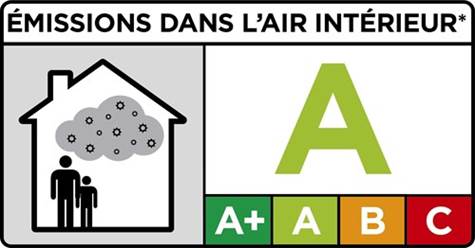A French regulation from 2011 (Grenelle law) stipulates that certain construction products must be labeled with an emission class from January 1, 2012. This regulation mainly affects construction products with a large surface area, such as wall, floor and ceiling cladding, coatings and insulating materials as well as windows and interior doors. The emissions analysis is based on DIN EN 16516. 10 individual substances are evaluated. In addition, the TVOC value is analyzed after 28 days in accordance with the table below.
| Classes | C | B | A | A+ |
| Formaldehyde | >120 | < 120 | < 60 | < 10 |
| Acetaldehyde | >400 | < 400 | < 300 | < 200 |
| Toluene | >600 | < 600 | < 450 | < 300 |
| Tetrachloroethylene | >500 | < 500 | < 350 | < 250 |
| Xylene | >400 | < 400 | < 300 | < 200 |
| 1,2,4-trimethylbenzene | >2000 | < 2000 | < 1500 | < 1000 |
| 1,4-dichlorobenzene | >120 | < 120 | < 90 | < 60 |
| Ethylbenzene | >1500 | < 1500 | < 1000 | < 750 |
| 2-butoxyethanol | >2000 | < 2000 | < 1500 | < 1000 |
| Styrene | >500 | < 500 | < 350 | < 250 |
| TVOC value toluene equivalent | >2000 | < 2000 | < 1500 | < 1000 |
Class A+ stands for particularly low-emission products and class C for the products with the highest emissions.
Depending on the result for the parameters of individual substances and TVOC value, a product is assigned to the highest (worst) emission class overall and labeled by the manufacturer with a corresponding emission label.

